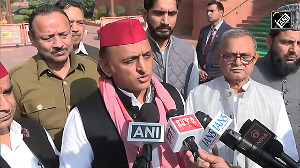The consumer durables player has modified its decades-old logo as it hopes to hold fresh appeal beyond ‘mums’ to include millennials, says Ritwik Sharma.
Illustration: Dominic Xavier/Rediff.com

Leading consumer durables player Whirlpool has recently introduced a new logo, modifying its decades-old earlier version to reflect its modernised brand values and offer a fresh appeal that goes beyond ‘mums’ to include millennials.
The multinational brand, which has been in existence for more than a century and is primarily associated with refrigerators and washing machines, is looking to tap newer categories like air purifiers and dish washers in an emerging market like India.
The developments with the new logo follow the company's foray into the e-commerce segment in India with its own store late last year.
Kapil Agarwal, vice-president, marketing, Whirlpool India, explains that the company is planning to take a more strategic stance on categories and build portfolios globally so that “we are no longer or a washing machine or refrigerator company”.
In the past, the logo had a swirl -- reflecting the company’s washing machine heritage -- on top of the letter W, which has been removed as the company wants to be identified with a host of appliances across cooking, dishwashing, air-conditioning and refrigeration.
Secondly, the font has changed from black to a more chic dark grey.
Agarwal reasons, “The millennial consumer is offering a lot of demographic dividend, particularly in an emerging market like India. The brand needs to relate and appeal to the 25-35 age bracket.”
Thirdly, the “ring of promise” around the logo has been enhanced to be presented in a three-dimensional light. “We call it the ring of promise and not reassurance, because we believe in core category (refrigerator or washing machine) performance,” says Agarwal.
Whirlpool commands 25 per cent share in the consumer durables market in India, which is expected to reach a size of US $20.6 billion (Rs 1,348.85 billion) by 2020.
According to the company, it is behind the leading players and Samsung and LG. Whirlpool has been falling behind the Korean giants, but it reported a 45.09 per cent jump in net profit in the last quarter posting Rs 55.44 crore.
Although the company is not disclosing any financial targets, Agarwal claims it is targeting to grow big in India with a “2x” growth in top line terms in the next three years.
“The key to this business is that it’s important to sustain the profitability that you have. We want to grow share through offering better value products to the consumer and better innovations,” he adds.
In order to do so, the company plans to focus on investments around innovation and expansion of capacity. “The core business is very underpenetrated in India. For example, one in five households has a refrigerator and almost one in 10 has a washing machine,” Agarwal says.
In India a category like dish washers, which commands a strong market in Europe and the US, is nascent. So, the company feels an inclusive focus would help penetrate such segments in emerging markets.
The company had long debated whether to do away with the ‘swirl’ but, as Agarwal points out, in the last one year a bigger need was felt to appeal to a younger audience rather than the brand being relegated to one addressing only “Whirlpool mums”.
“We wanted to appeal to younger audience, including newly married couples and even double-income households with no children.”
Similarly, the brand’s communication has evolved in the last six years.
From 2005 to 2012, actors Ajay Devgn and Kajol were the celebrity endorsers. At that point, the positioning was mass and mass premium.
That changed with an attempt to make it more international and incorporate aspirational values linked to an MNC.
Between 2013 and 2016, the company tried to woo a younger audience, who are not “technophobes”. The messaging built around the brand is one that is “designed to delight” with every appliance.
The company promises to launch several high-end products this year, be it a large refrigerator or frontload washing machine.
According to N Chandramouli, CEO, TRA, a sharp logo with minimal elements is the norm today.
“Be it a Samsung or an LG, their logos are simple and straightforward and they all want to appeal to everybody and not millennials alone,” he says, adding that given the technology available which allows for replicating a screen logo on print, the revamp for Whirlpool was overdue.
He points out that Whirlpool earlier faced the issue of consumers linking it with washing machines purely because of the name. And although such decisions may be protracted in a big organisation like Whirlpool, a logo should always reflect what the brand wishes to communicate, he stresses.











